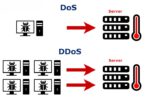SATA vs EIDE
Summary: Difference Between SATA and EIDE is that SATA (Serial Advanced Technology Attachment) uses serial signals to transfer data, instructions, and information. While EIDE (Enhanced Integrated Drive Electronics) is a hard disk interface that uses parallel signals to transfer data, instructions, and information.

SATA
SATA (Serial Advanced Technology Attachment) uses serial signals to transfer data, instructions, and information. The primary advantage of SATA interfaces is their cables are thinner, longer, more flexible, and less susceptible to interference than cables used by hard disks that use parallel signals. SATA interfaces also support connections to optical disc drives. External disks use the eSATA (external SATA) interface, which is much faster than USB and FireWire.
EIDE
EIDE (Enhanced Integrated Drive Electronics) is a hard disk interface that uses parallel signals to transfer data, instructions, and information. EIDE interfaces can support up to four hard disks at 137 GB per disk. EIDE interfaces also provide connections for optical disc drives and tape drives.
Also Read:
Difference Between SATA and SAS
Difference Between SATA and SCSI
Difference Between EIDE and SCSI







Leave a Comment
You must be logged in to post a comment.